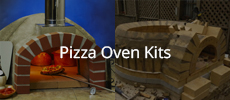Announcement
Collapse
No announcement yet.
Another WFO in the UK - 42" Pompeii
Collapse
X
-
Tapered arch looks right on the button. Life will be good as you do the dome. I built my arch as I did courses but keeping the arch ahead of the dome course. Remember to make corrections on the dome near the front half of the dome. No one will see in this area.Last edited by UtahBeehiver; 07-14-2018, 03:49 PM.
-
And now the final stage, the two lines i had made are joined together to give me a line to cut, really pleased with how this turned out in the end, worth spending the whole day on it, i would have liked to have mortared it too but il settle for that for a days work. Oh i did drop a brick from the arch which landed on my first ring and broke 2 joins so im going to have to pull those up to re lay them!
Im not sure i fancy laying all of these arch bricks in one go incase i unsettle some as i tap them into position, so i might just do one or two each time i mix up a batch of homebrew6 Photos
Leave a comment:
-
Thanks Russell, having a bit of trouble getting the pics to upload in the right order so i just deleted my post and posted it again, i have the rest of the arch cut so i will upload the rest of the pics now, shame i cant upload all at once!
So this shows the bricks with their first stage of cutting, then i laid them out on the arch template to mark up for the next stage (didnt get pictures on the arch template) using a piece of string asmongota suggested in my other thread about arch placement, holding each brick in its correct place on the arch and having the string run from the dome centre and past the brick, i marked the outer and inner radius on the string which i could then transfer these marks to my bricks to get my first line to cut in the second stage of cutting the arch bricks. As many people have already said, its easy to think that all of these bricks are the same, but they are not, every so slightly different each time, you can see after all are marked up and then laid out flat that there is a gentle curve in then back out
I then cut all bricks after i had all the individual markings, and popped them back on the arch template for stage 3 cuts which i used my pencil attachment set to my inner radius, i could then draw the line for the next cut, a pencil mark was made along the inner side of the arch template all the way around the arch to tell me which lines to join up, as soon as each brick had these two lines i could join the lines together to make the final cuts6 Photos
Leave a comment:
-
Today i managed to get the tapered arch bricks cut, feels great to have that done but it did take me all day just to cut the bricks!
Here is the first stage, cutting the side tapers on all arch bricks
I wrapped the base in cling wrap to protect it from water and stop the spread of nasty dust
6 PhotosLast edited by brad mole; 07-14-2018, 12:21 PM.
Leave a comment:
-
Very nice work on phase one. Here is a pic showing how to use the IT for cutting the taper inner arch. Remember, the cuts are "NOT" symmetrical and each brick is slightly different with the top dead center brick being the longest length brick. Although the pic is show a partial arch rather than a full arch, the concept is still the same.
1 Photo
Leave a comment:
-
Thanks everyone for the great advice as always, it all makes sense wht you have said and i dont know why it didnt cross my mind when i was laying the bricks, i didnt clean the excess cutting dust off most bricks, i also wiped clean the surfaces straight after laying the bricks, maybe every 3 bricks or so, so this could explain the cracking like gulf has said, hopefully meaning the cracks are only on the outside, i give them a good wiggle and they seem pretty sturdy so i think im going to leave them as they are and learn from my mistakes what i will change from now on. clean water, scrub each brick clean, lay bricks within a few seconds of applying mortar, and dont clean joins until 15 mins or so after laying. I will also have a play with different consistencies of mix to see if any stick better.
Heres are some pics of the cracks, hard to see they are really quite small
2 Photos
Leave a comment:
-
Another thing I had to watch for on my bricks was dust/dirt. I used salvaged and new bricks, obviously I cleaned off the salvaged bricks but was surprised that most of my new bricks had enough dust on them to keep the mortar from adhering properly. Some of it was truly just dust and some was residue from cutting the bricks. I ended up just taking a wet brush and cloth to the bricks followed by a quick dip in a bucket of clean water. I usually just cleaned enough bricks for the work I intended for that session. The mortar stuck pretty well to those clean and moist brick surfaces.
If you think your mortar is the correct consistency as noted by the above posts and it's still not appearing to stick...make sure the bricks are cleaned of any surface contaminants that might be interfering with the bonding process. My brother in law (who was a professional brick layer) told me that often times if they were having trouble with a batch of mortar sticking, they could trace it back to someone using dirty water when they mixed that batch. Solution - throw out that batch of mortar and make a new one with clean water.
Leave a comment:
-
I started going for "peanut butter", which for the kind of PB I eat was way too dry. I ended up pulling out my first layer of bricks as the mortar was too dry and it pulled away from the bricks. I found if I mixed the mortar wet and added dry mix to where if I ran my trowel through the bucket the mortar would just start to hold ridges it worked well. At that point it is way wetter than peanut butter.
Leave a comment:
-
I have seen what appeared to be the mortar pulling away when it was actually only happening near the surface. That sometimes will happen when the mortar is sliced flush with the brick immediately after it is layed. That leaves the outer edge exposed to air. If it is hot, I will have a fan blowing on me which compounds the problem of the joint surface drying too quickly. My advice is to leave the flash that squeezes outside, undesturbed for about 15 to 20 minutes. Then tool (press) it back into the joint. That said, a brick has to be placed immediately after the mortar is spread. If it is moved after a few seconds of laying, the cohesion is lost. It then must be removed and fresh mortar applied.
Leave a comment:
-
Ok thanks for the info guys, i was soaking them for a few minutes then leaving them out for a few minutes to dry a little on the surface, i like the idea of the mist spray and i think i will lay a wet cloth over at the end of each session to keep things moist underneath. As for the consistency i was aiming for 'peanut butter' consistency which is what i had read on here, is that correct? im doing a homebrew mix of 3 (sand) to 1 (lime) 1 (cement) 1 (fireclay) mixing dry then adding water until its just right
Leave a comment:
-
I agree that the mortar needs to be at the correct consistency and that the brick should not be powder house dry. However, I question what "thoroughly wet the bricks" means. If that means soaking them in a bucket, or flooding them with a water hose, I disagree. Brick must be able to pull some mositure from the mortar to enable the bond. For firebrick, (on the hottest, dryest day) I have not seen any extra moisture needed other than a quick mist from spritz bottle. Set it for a fine mist and lightly spray the brick just before laying. If fthe water soaks imediately in to the brick, your ok with the spritz bottle. If it takes over 2 to 3 seconds to soak in, put the bottle to the side and just lay the brick without spritzing.Last edited by Gulf; 07-11-2018, 06:30 PM.
- Likes 1
Leave a comment:
-
It seems to me that any time a brick, stone or piece of tile is sucking water out of mortar that's a Bad Thing. My understanding is that cements and mortars attain maximum strength if kept wet throughout the curing process. Having the brick or tile take up water often results in a small separation between the brick and mortar, surely not good. Wet mixes of portland cement containing concretes and mortars aren't as strong as drier ones. I think it is prudent and a more controlled process to thoroughly wet the bricks then use a mortar mix at the right consistency to stick rather than using an overly wet mixture in hopes of compensating for dry bricks.
Leave a comment:
-
The outer joint width will be what it works out to be and just filled with mortar. But that said, if you want parallel tight side joint space then that is up to you, I did this, but no one really sees this once your done and it does take more time to get exact. Brick wetness, it will depend on the water content of the mortar, how hot it is, how wet or dry the bricks are. You will get a feel for it as you lay more courses.
Leave a comment:
-
Yes thats one bit of advice i did have in mind was to keep the cuts for where you wont see them in the end, thanks for that! yes i think i will start beveling on the next course, i thought i knew exactly what i was going to do but now im having second thoughts, i know the intention is to keep tight inner joins, but if i intend to have parallel mortar joins like i have in the first ring, then that means i will have mortar thickness on every join of around 3mm, so would that mean to get a tight inner join i would not be aiming for a parallel join (when looking down from above) and aim for the mortar join to look tapered from zero at the inner edge to 3mm or more at the outer edge?Originally posted by UtahBeehiver View PostNice start, see you took my advice and made an adjustment to the course toward the front of the dome. One thing, as you move up and start beveling, only cut a few bricks first (maybe 6 or so) to see how they fit instead of the full course just to make sure the bevels are correct. Are you soaking the bricks before you lay them? If not they may be absorbing the water from the mortar too quickly.
Yes i soaked the bricks but some more than others, and some i left out to dry a little after soaking, maybe im supposed to lay them when they are still soaking wet?
Cheers micky, no problem, yes its unheard of over here to have such a dry and warm spell isnt it? il try soaking them for longer next time. although they seemed to be cracking as they dried at the time, i went back in the morning and the cracks didnt get any worse, so i have maybe 4 or 5 small cracks where it looks like the mortar has started to creep away from the brick, very small though like a hairline crack, does everyone think this is acceptable or should i rebuild?Originally posted by MickyPizza View PostHi Brad. Will reply to your first message later. Just a note on the drying mortar. I also seen something somewhere else about soaking bricks..
Id take into consideration the current heat wave the UK is enduring. We're used to RAIN. But there's been little or none for weeks. Your garden as well as your supplier has been parched. I'm still at the stone foundations stage (next step concrete hearth plinth) and my muck was drying up as quick as I was making it. Great inspiration this thread though mate. Well done!
Leave a comment:
-
Hi Brad. Will reply to your first message later. Just a note on the drying mortar. I also seen something somewhere else about soaking bricks..
Id take into consideration the current heat wave the UK is enduring. We're used to RAIN. But there's been little or none for weeks. Your garden as well as your supplier has been parched. I'm still at the stone foundations stage (next step concrete hearth plinth) and my muck was drying up as quick as I was making it. Great inspiration this thread though mate. Well done!
Leave a comment:





Leave a comment: